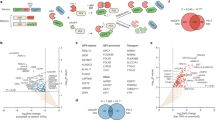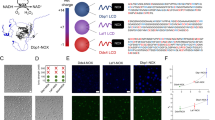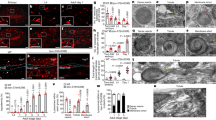Abstract
Rumi O-glucosylates the EGF repeats of a growing list of proteins essential in metazoan development, including Notch. Rumi is essential for Notch signaling, and Rumi dysregulation is linked to several human diseases. Despite Rumi's critical roles, it is unknown how Rumi glucosylates a serine of many but not all EGF repeats. Here we report crystal structures of Drosophila Rumi as binary and ternary complexes with a folded EGF repeat and/or donor substrates. These structures provide insights into the catalytic mechanism and show that Rumi recognizes structural signatures of the EGF motif, the U-shaped consensus sequence, C-X-S-X-(P/A)-C and a conserved hydrophobic region. We found that five Rumi mutations identified in cancers and Dowling–Degos disease are clustered around the enzyme active site and adversely affect its activity. Our study suggests that loss of Rumi activity may underlie these diseases, and the mechanistic insights may facilitate the development of modulators of Notch signaling.
This is a preview of subscription content, access via your institution
Access options
Subscribe to this journal
Receive 12 print issues and online access
$259.00 per year
only $21.58 per issue
Buy this article
- Purchase on Springer Link
- Instant access to full article PDF
Prices may be subject to local taxes which are calculated during checkout





Similar content being viewed by others
References
Rana, N.A. & Haltiwanger, R.S. Fringe benefits: functional and structural impacts of O-glycosylation on the extracellular domain of Notch receptors. Curr. Opin. Struct. Biol. 21, 583–589 (2011).
Kopan, R. & Ilagan, M.X. The canonical Notch signaling pathway: unfolding the activation mechanism. Cell 137, 216–233 (2009).
Acar, M. et al. Rumi is a CAP10 domain glycosyltransferase that modifies Notch and is required for Notch signaling. Cell 132, 247–258 (2008).
Fernandez-Valdivia, R. et al. Regulation of mammalian Notch signaling and embryonic development by the protein O-glucosyltransferase Rumi. Development 138, 1925–1934 (2011).
Leonardi, J., Fernandez-Valdivia, R., Li, Y.D., Simcox, A.A. & Jafar-Nejad, H. Multiple O-glucosylation sites on Notch function as a buffer against temperature-dependent loss of signaling. Development 138, 3569–3578 (2011).
Lee, T.V. et al. Negative regulation of notch signaling by xylose. PLoS Genet. 9, e1003547 (2013).
Haltom, A.R. et al. The protein O-glucosyltransferase Rumi modifies eyes shut to promote rhabdomere separation in Drosophila. PLoS Genet. 10, e1004795 (2014).
Ramkumar, N. et al. Protein O-glucosyltransferase 1 (POGLUT1) promotes mouse gastrulation through modification of the apical polarity protein CRUMBS2. PLoS Genet. 11, e1005551 (2015).
Thakurdas, S.M. et al. Jagged1 heterozygosity in mice results in a congenital cholangiopathy which is reversed by concomitant deletion of one copy of Poglut1 (Rumi). Hepatology 63, 550–565 (2016).
Basmanav, F.B. et al. Mutations in POGLUT1, encoding protein O-glucosyltransferase 1, cause autosomal-dominant Dowling-Degos disease. Am. J. Hum. Genet. 94, 135–143 (2014).
Lombard, V., Golaconda Ramulu, H., Drula, E., Coutinho, P.M. & Henrissat, B. The carbohydrate-active enzymes database (CAZy) in 2013. Nucleic Acids Res. 42, D490–D495 (2014).
Lazarus, M.B. et al. Structural snapshots of the reaction coordinate for O-GlcNAc transferase. Nat. Chem. Biol. 8, 966–968 (2012).
Lazarus, M.B., Nam, Y., Jiang, J., Sliz, P. & Walker, S. Structure of human O-GlcNAc transferase and its complex with a peptide substrate. Nature 469, 564–567 (2011).
Lizak, C., Gerber, S., Numao, S., Aebi, M. & Locher, K.P. X-ray structure of a bacterial oligosaccharyltransferase. Nature 474, 350–355 (2011).
Lazarus, M.B. et al. HCF-1 is cleaved in the active site of O-GlcNAc transferase. Science 342, 1235–1239 (2013).
Schimpl, M. et al. O-GlcNAc transferase invokes nucleotide sugar pyrophosphate participation in catalysis. Nat. Chem. Biol. 8, 969–974 (2012).
Vasudevan, D. & Haltiwanger, R.S. Novel roles for O-linked glycans in protein folding. Glycoconj. J. 31, 417–426 (2014).
Chen, C.I. et al. Structure of human POFUT2: insights into thrombospondin type 1 repeat fold and O-fucosylation. EMBO J. 31, 3183–3197 (2012).
Lira-Navarrete, E. et al. Structural insights into the mechanism of protein O-fucosylation. PLoS One 6, e25365 (2011).
Valero-González, J. et al. A proactive role of water molecules in acceptor recognition by protein O-fucosyltransferase 2. Nat. Chem. Biol. 12, 240–246 (2016).
Yu, H. et al. Notch-modifying xylosyltransferase structures support an SNi-like retaining mechanism. Nat. Chem. Biol. 11, 847–854 (2015).
Wouters, M.A. et al. Evolution of distinct EGF domains with specific functions. Protein Sci. 14, 1091–1103 (2005).
Takeuchi, H., Kantharia, J., Sethi, M.K., Bakker, H. & Haltiwanger, R.S. Site-specific O-glucosylation of the epidermal growth factor-like (EGF) repeats of notch: efficiency of glycosylation is affected by proper folding and amino acid sequence of individual EGF repeats. J. Biol. Chem. 287, 33934–33944 (2012).
Liu, Q. et al. Structures from anomalous diffraction of native biological macromolecules. Science 336, 1033–1037 (2012).
Holm, L. & Rosenstrom, P. Dali server: conservation mapping in 3D. Nucleic Acids Res. 38, W545–W549 (2010).
Larivière, L., Sommer, N. & Morera, S. Structural evidence of a passive base-flipping mechanism for AGT, an unusual GT-B glycosyltransferase. J. Mol. Biol. 352, 139–150 (2005).
Takeuchi, H. et al. Rumi functions as both a protein O-glucosyltransferase and a protein O-xylosyltransferase. Proc. Natl. Acad. Sci. USA 108, 16600–16605 (2011).
Xu, A., Lei, L. & Irvine, K.D. Regions of Drosophila Notch that contribute to ligand binding and the modulatory influence of Fringe. J. Biol. Chem. 280, 30158–30165 (2005).
Rana, N.A. et al. O-glucose trisaccharide is present at high but variable stoichiometry at multiple sites on mouse Notch1. J. Biol. Chem. 286, 31623–31637 (2011).
Lairson, L.L., Henrissat, B., Davies, G.J. & Withers, S.G. Glycosyltransferases: structures, functions, and mechanisms. Annu. Rev. Biochem. 77, 521–555 (2008).
Breton, C., Fournel-Gigleux, S. & Palcic, M.M. Recent structures, evolution and mechanisms of glycosyltransferases. Curr. Opin. Struct. Biol. 22, 540–549 (2012).
Larivière, L., Gueguen-Chaignon, V. & Morera, S. Crystal structures of the T4 phage beta-glucosyltransferase and the D100A mutant in complex with UDP-glucose: glucose binding and identification of the catalytic base for a direct displacement mechanism. J. Mol. Biol. 330, 1077–1086 (2003).
Ntziachristos, P., Lim, J.S., Sage, J. & Aifantis, I. From fly wings to targeted cancer therapies: a centennial for Notch signaling. Cancer Cell 25, 318–334 (2014).
Rampias, T. et al. A new tumor suppressor role for the Notch pathway in bladder cancer. Nat. Med. 20, 1199–1205 (2014).
Klinakis, A. et al. A novel tumour-suppressor function for the Notch pathway in myeloid leukaemia. Nature 473, 230–233 (2011).
Cerami, E. et al. The cBio cancer genomics portal: an open platform for exploring multidimensional cancer genomics data. Cancer Discov. 2, 401–404 (2012).
Wang, N.J. et al. Loss-of-function mutations in Notch receptors in cutaneous and lung squamous cell carcinoma. Proc. Natl. Acad. Sci. USA 108, 17761–17766 (2011).
Agrawal, N. et al. Exome sequencing of head and neck squamous cell carcinoma reveals inactivating mutations in NOTCH1. Science 333, 1154–1157 (2011).
Jonusiene, V. et al. Down-regulated expression of Notch signaling molecules in human endometrial cancer. Med. Oncol. 30, 438 (2013).
Hanneken, S. et al. [Galli-Galli disease. Clinical and histopathological investigation using a case series of 18 patients]. Hautarzt. 62, 842–851 (2011).
Mauerer, A., Betz, R.C., Pasternack, S.M., Landthaler, M. & Hafner, C. Generalized solar lentigines in a patient with a history of radon exposure. Dermatology 221, 206–210 (2010).
Andersson, E.R. & Lendahl, U. Therapeutic modulation of Notch signalling—are we there yet? Nat. Rev. Drug Discov. 13, 357–378 (2014).
Rizzo, P. et al. Rational targeting of Notch signaling in cancer. Oncogene 27, 5124–5131 (2008).
Kabsch, W. Xds. Acta Crystallogr. D Biol. Crystallogr. 66, 125–132 (2010).
Battye, T.G., Kontogiannis, L., Johnson, O., Powell, H.R. & Leslie, A.G. iMOSFLM: a new graphical interface for diffraction-image processing with MOSFLM. Acta Crystallogr. D Biol. Crystallogr. 67, 271–281 (2011).
Otwinowski, Z. & Minor, W. Processing of X-ray diffraction data collected in oscillation mode. Methods Enzymol. 276, 307–326 (1997).
Winn, M.D. et al. Overview of the CCP4 suite and current developments. Acta Crystallogr. D Biol. Crystallogr. 67, 235–242 (2011).
Schneider, T.R. & Sheldrick, G.M. Substructure solution with SHELXD. Acta Crystallogr. D Biol. Crystallogr. 58, 1772–1779 (2002).
Adams, P.D. et al. PHENIX: a comprehensive Python-based system for macromolecular structure solution. Acta Crystallogr. D Biol. Crystallogr. 66, 213–221 (2010).
Vagin, A. & Teplyakov, A. Molecular replacement with MOLREP. Acta Crystallogr. D Biol. Crystallogr. 66, 22–25 (2010).
Emsley, P., Lohkamp, B., Scott, W.G. & Cowtan, K. Features and development of Coot. Acta Crystallogr. D Biol. Crystallogr. 66, 486–501 (2010).
Pannu, N.S., Murshudov, G.N., Dodson, E.J. & Read, R.J. Incorporation of prior phase information strengthens maximum-likelihood structure refinement. Acta Crystallogr. D Biol. Crystallogr. 54, 1285–1294 (1998).
Acknowledgements
We thank members of the Li and Haltiwanger labs for critical comments on this work, as well as S. Singh Johar for technical assistance. The work was supported by the NIH (grants GM061126 (to R.S.H.) and AG029979 (to H.L.)) and SBU–BNL (seed grant to R.S.H. and H.L.). We acknowledge access to beamlines X25, X29 and X4A at NSLS, Brookhaven National Laboratory and LRL-CAT at APS, Argonne National Laboratory, and we thank the staff at these beamlines. NSLS and APS were supported by the US Department of Energy, Office of Science, Office of Basic Energy Sciences, under contract nos. DE-AC02-98CH10886 and DE-AC02-06CH11357, respectively. Use of the Lilly Research Laboratories Collaborative Access Team (LRL-CAT) beamline at Sector 31 of the Advanced Photon Source was provided by Eli Lilly Company, which operates the facility. The results published here are in part based on data generated by the TCGA Research Network (http://cancergenome.nih.gov/). H.L. dedicates this work to the loving memory of his son Paul J. Li.
Author information
Authors and Affiliations
Contributions
H.Y., H.T., R.S.H. and H.L. designed the research. H.Y. prepared the protein complexes, performed crystallization and solved the structures. H.Y. and Q.L. collected and processed the sulfur-SAD data. H.Y. and H.L. analyzed the structures. H.T., M.T. and J.K. expressed and purified proteins and mutants and performed the enzymatic assays and mass spectrometry. H.Y., H.T., R.S.H. and H.L. designed the mutants, analyzed the mutant data and carried out the cancer-related analysis. H.Y. prepared the initial draft of the manuscript, and H.Y., H.T., R.S.H. and H.L. wrote the paper with input from all other authors.
Corresponding authors
Ethics declarations
Competing interests
The authors declare no competing financial interests.
Supplementary information
Supplementary Text and Figures
Supplementary Results, Supplementary Figures 1–8 and Supplementary Tables 1–3. (PDF 3304 kb)
Rights and permissions
About this article
Cite this article
Yu, H., Takeuchi, H., Takeuchi, M. et al. Structural analysis of Notch-regulating Rumi reveals basis for pathogenic mutations. Nat Chem Biol 12, 735–740 (2016). https://doi.org/10.1038/nchembio.2135
Received:
Accepted:
Published:
Issue Date:
DOI: https://doi.org/10.1038/nchembio.2135
This article is cited by
-
Structure, function, and pathology of protein O-glucosyltransferases
Cell Death & Disease (2021)
-
POGLUT1 biallelic mutations cause myopathy with reduced satellite cells, α-dystroglycan hypoglycosylation and a distinctive radiological pattern
Acta Neuropathologica (2020)
-
Emerging structural insights into glycosyltransferase-mediated synthesis of glycans
Nature Chemical Biology (2019)
-
Legionella effector SetA as a general O-glucosyltransferase for eukaryotic proteins
Nature Chemical Biology (2019)
-
Structural basis of protein arginine rhamnosylation by glycosyltransferase EarP
Nature Chemical Biology (2018)



